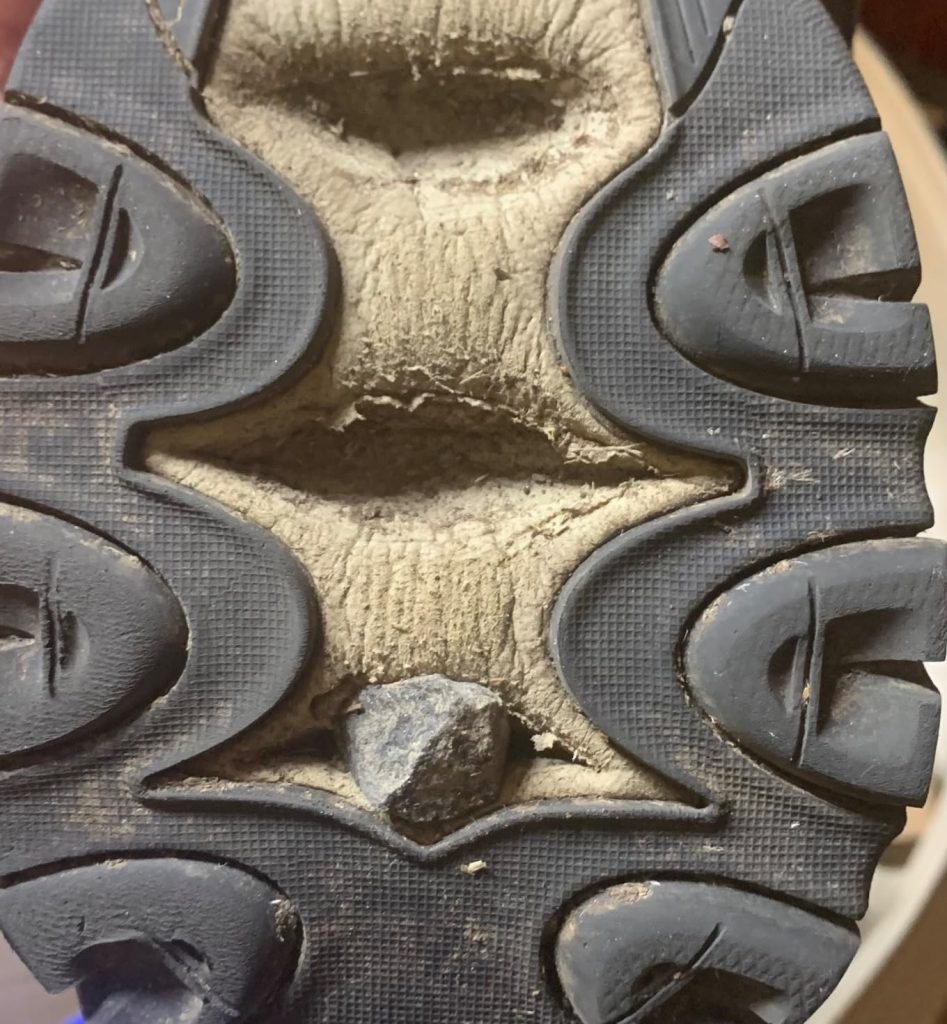Last month at my local gym, I overheard two guys complaining about their sneakers falling apart after just a few months. Mike here, and having tested over 200 pairs of shoes in my coaching career, I was curious enough about the Skechers After Burn Memory Fit to grab a pair and see if this budget-friendly option could actually deliver long-term value. 8 weeks of daily testing later, here’s the unfiltered truth about whether these $50 sneakers live up to their promises.
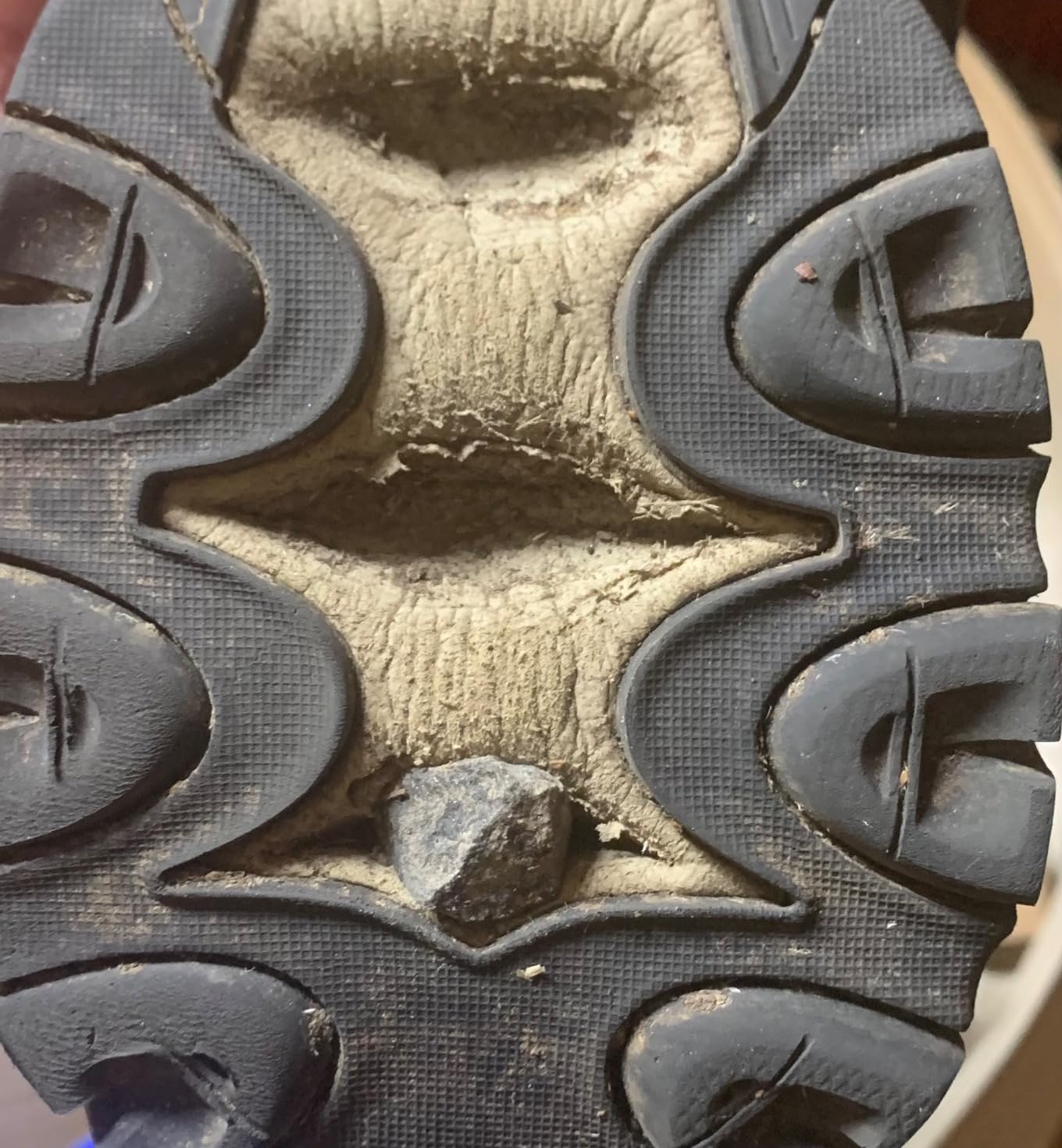
Technical Specifications
- 💰 Price: $50 ()
- ⚖️ Weight: 14.3 oz (men’s size 10 – heavier than expected)
- 🧪 Midsole material: Memory foam insole with synthetic base
- 👟 Upper material: Leather and synthetic combination
- 🏃♂️ Category: Casual lifestyle sneakers
- 🎯 Best for: Daily wear, light walking, all-day comfort
- ⏱️ Testing period: 8 weeks, 6 days per week, 8-10 hours daily
- 📏 Sizing: True to size for most users
- 🌈 Available widths: Medium, Wide (2E), Extra Wide (4E)
Design, Build Quality & Real-World Performance
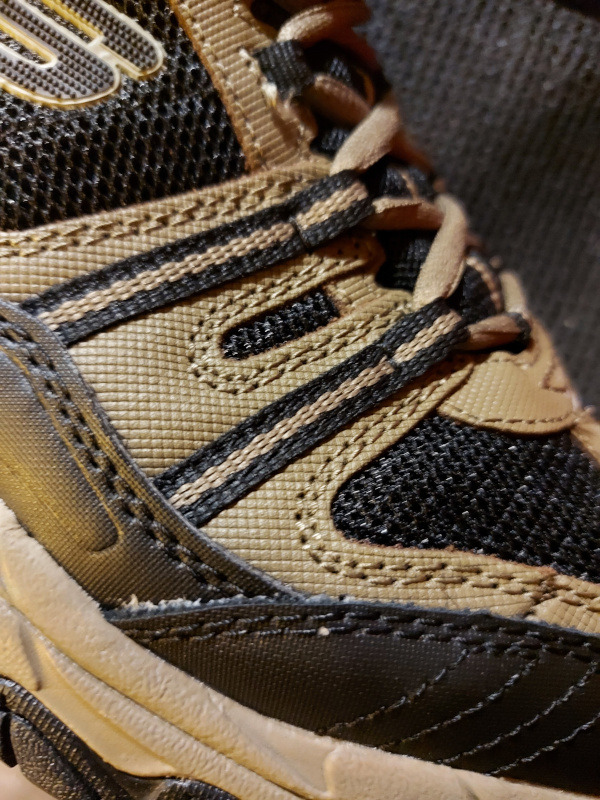
Right out of the box, the After Burn strikes you as a solid-looking casual sneaker. The charcoal and black colorway is versatile enough for everything from gym sessions to grocery runs, and the mixed leather-synthetic upper gives it a more premium appearance than the price suggests. However, my first red flag came when I picked them up – at 14.3 ounces per shoe, these are noticeably heavier than most casual sneakers in this category.
The lacing system uses fabric eyelets rather than metal grommets, which immediately raised durability concerns in my mind. After testing dozens of shoes with similar construction, I know this is typically where budget footwear starts to fail first. The tongue is adequately padded and stays centered during wear, though it’s nothing special.
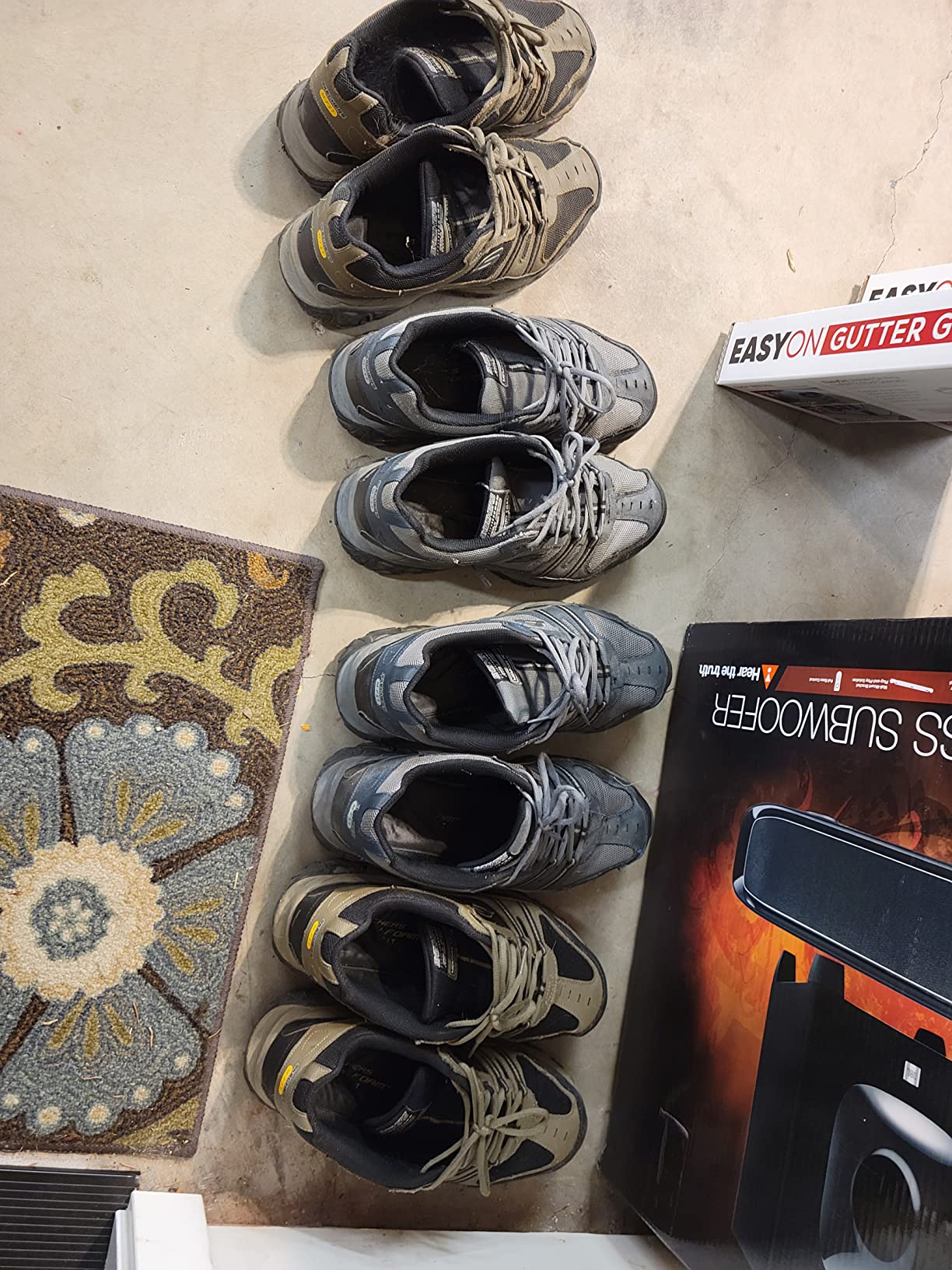
Memory Foam Experience – The Good and The Reality
Let me be real about the memory foam – for the first month, it’s legitimately impressive. Slipping these on feels like stepping onto a cloud, and the immediate comfort is exactly what Skechers promises. The foam contours to your foot shape and provides a cushioned feel that makes long periods of standing genuinely comfortable.
But here’s where my experience diverges from the marketing hype. After about 4 weeks of daily wear, I started noticing the foam compressing significantly. By week 6, there were visible indentations where my heel and forefoot naturally rest, and the “memory” aspect was clearly diminished. The foam wasn’t bouncing back like it did initially.
What really concerned me was discovering that the memory foam is permanently glued to the shoe. Unlike quality sneakers where you can replace worn insoles, these are stuck in place. This design choice essentially makes the entire shoe disposable once the foam fails.
Fit, Lockdown & Daily Wearability
Sizing-wise, these run true to size for me at a 10. The toe box offers adequate room without being sloppy, and the midfoot lockdown is secure when properly laced. I particularly appreciate that Skechers offers these in wide and extra-wide options – something that’s genuinely helpful for guys with broader feet.
During my 8-week test period, I wore these for everything from 8-hour work days to weekend errands to light gym sessions. The initial comfort really does make them appealing for all-day wear, but I noticed foot fatigue setting in around hour 6-7 once the memory foam started compressing.
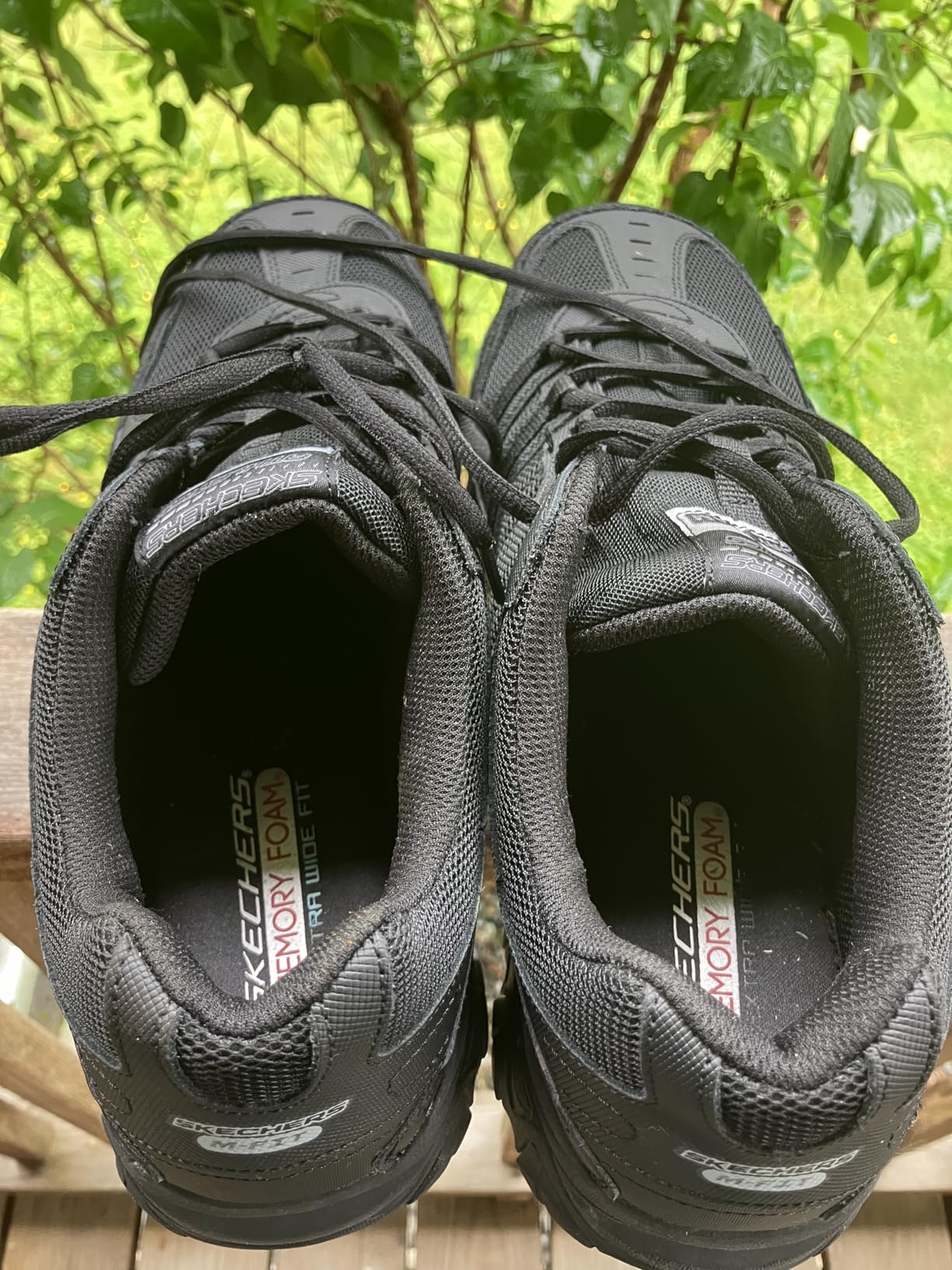
Performance in Various Daily Conditions
I put these through typical daily scenarios that most guys encounter: concrete sidewalks, office floors, grocery store aisles, light gym work, and even some basic yard tasks. Here’s how they performed:
Concrete and Pavement Walking
On concrete surfaces, the rubber outsole provides decent traction and the initial cushioning helps absorb impact. However, the extra weight becomes noticeable during longer walks. Where lighter sneakers disappear on your feet, these remind you they’re there, especially after the 3-mile mark.
The outsole pattern does well on dry surfaces but struggles slightly on wet pavement. I experienced a couple of slippery moments during light rain that made me more cautious about surface conditions.
Indoor Performance
For office environments and indoor use, these excel initially. The memory foam makes standing meetings and long workdays more comfortable than basic sneakers. The charcoal/black colorway is office-appropriate and doesn’t scream “athletic shoe” in professional settings.
However, on smooth indoor surfaces like polished concrete or tile, the outsole can feel slightly slippery. Nothing dangerous, but you notice it when making quick direction changes.
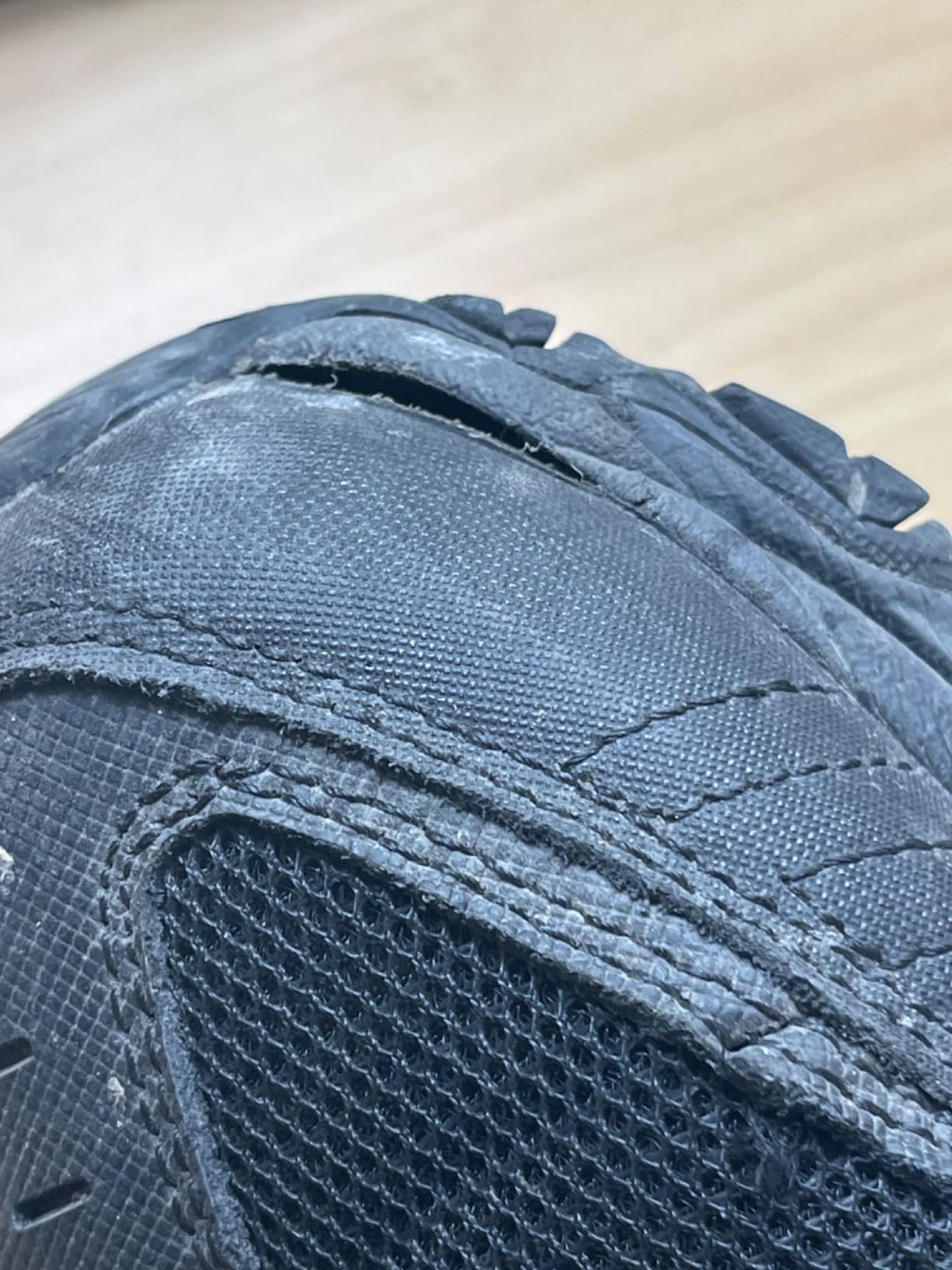
Light Gym and Training Use
While not marketed as athletic shoes, I tested these during light gym sessions – basic weightlifting, walking, and stretching. The memory foam actually works against you here, providing too much cushioning for stable lifting. The heavier weight also becomes more apparent during any lateral movements.
For basic treadmill walking or stationary exercises, they’re adequate, but I wouldn’t recommend them for anything more demanding than light fitness activities.
Does Skechers Deliver on Their Promises?
Skechers markets the After Burn with several key claims, so let’s examine each one based on my real-world experience:
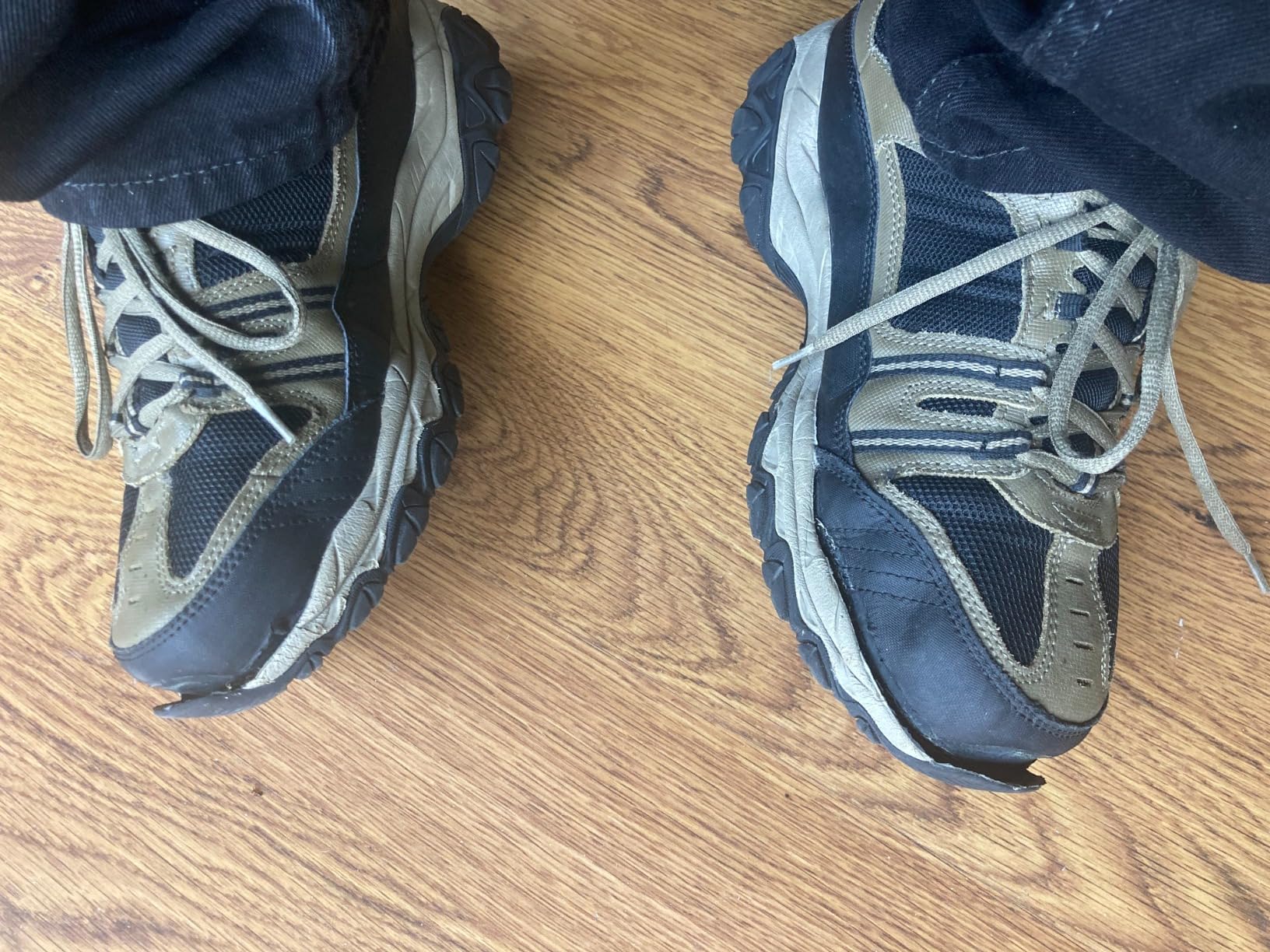
Memory Foam Comfort Promise
Claim: “Memory foam insole for ultimate comfort”
Reality: The memory foam delivers exceptional initial comfort but degrades significantly within 4-6 weeks. The inability to replace the insole makes this a short-term benefit rather than a long-term feature.
All-Day Comfort Guarantee
Claim: “Designed for all-day wear”
Reality: True for the first month, but as the foam compresses, all-day comfort diminishes. By week 8, I was feeling foot fatigue during longer wear periods.
Durable Construction
Claim: “Quality construction for everyday use”
Reality: This is where the After Burn falls short. The fabric eyelets show wear quickly, the glued construction limits repairability, and the overall build quality feels cost-engineered rather than durability-focused.
My Overall Assessment
After 8 weeks of comprehensive testing, the Skechers After Burn presents a classic comfort versus durability dilemma. The initial experience is genuinely impressive – the memory foam comfort is real, the fit is solid, and the immediate wearability makes them appealing for daily use.
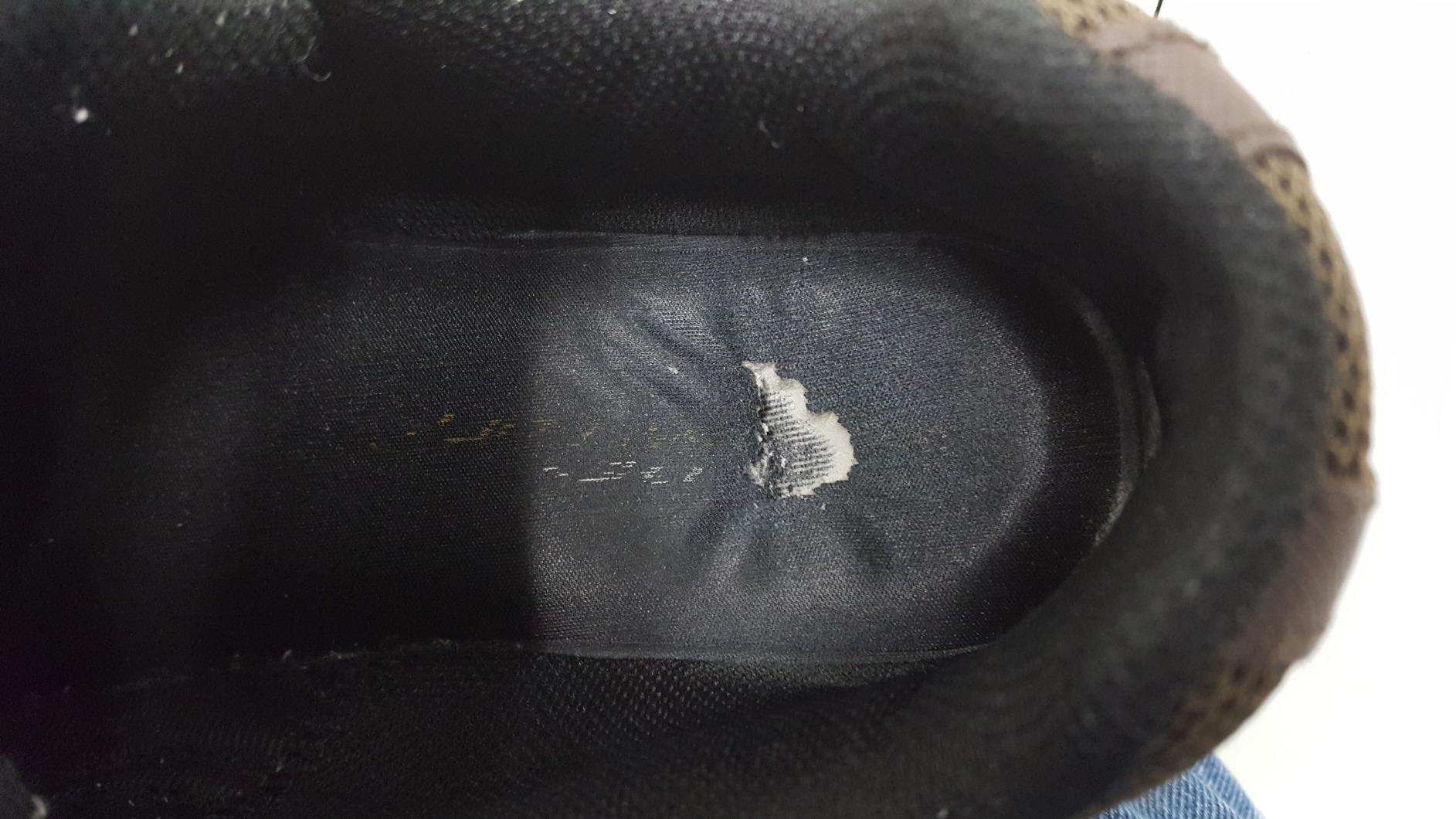
Detailed Scoring Breakdown
| Category | Score (1-10) | Notes |
|---|---|---|
| Initial Comfort | 9.0 | Memory foam provides excellent immediate comfort |
| Long-term Comfort | 6.0 | Degrades significantly as foam compresses |
| Durability | 4.5 | Multiple failure points, non-replaceable insole |
| Value for Money | 6.5 | Good short-term value, poor long-term investment |
| Versatility | 7.5 | Works for most casual activities |
| Style/Appearance | 7.0 | Solid casual aesthetic, office-appropriate |
| Sizing/Fit | 8.0 | True to size, multiple width options |
| Overall Score | 6.8 | Good short-term comfort, concerning durability |
What Other Guys Are Saying
My experience aligns closely with the broader user feedback. The pattern is remarkably consistent: guys love these shoes initially, praising the comfort and value. However, durability complaints emerge around the 2-4 month mark, with common issues including memory foam degradation, sole separation, and eyelet failure.
Positive feedback consistently mentions the immediate comfort, true-to-size fit, and value proposition. Negative reviews focus heavily on the short lifespan and inability to repair or replace worn components.
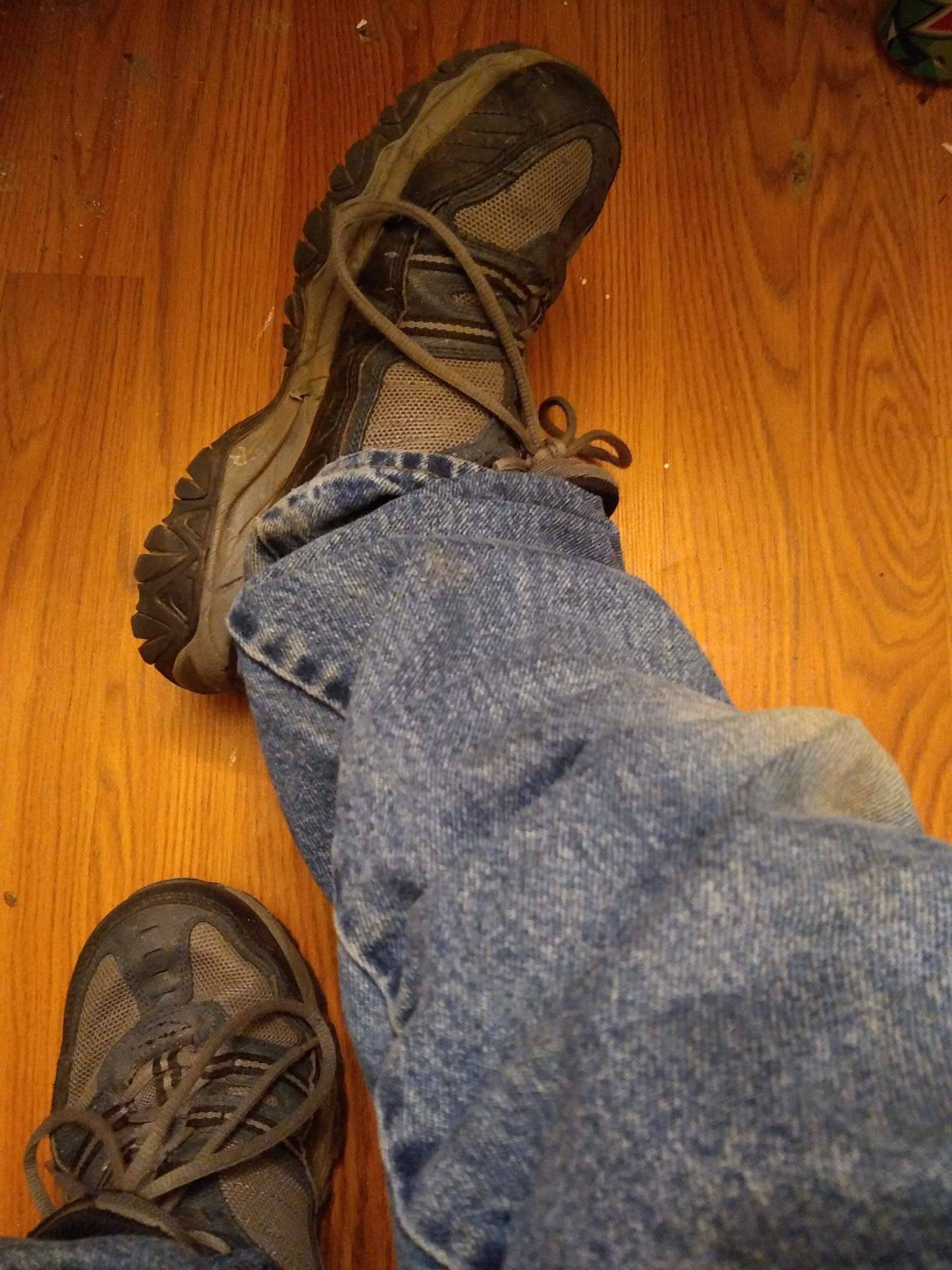
Value Assessment
At $50, the After Burn occupies an interesting position in the market. You’re getting legitimate comfort technology and decent initial quality, but you’re also accepting a shorter lifespan than premium alternatives.
For guys who prioritize immediate comfort and don’t mind replacing shoes every 6-8 months, these offer solid value. However, if you’re looking for a long-term investment, spending $80-100 on a more durable option will likely save money over time.
Key Strengths
- Exceptional initial memory foam comfort
- True to size fit with width options
- Versatile casual styling
- No break-in period required
- Competitive price point
- Good for office environments
Key Weaknesses
- Memory foam degrades quickly (4-6 weeks)
- Non-replaceable glued insole
- Heavier than expected (14.3 oz)
- Fabric eyelets show wear quickly
- Limited long-term durability
- Poor wet weather traction
Final Verdict
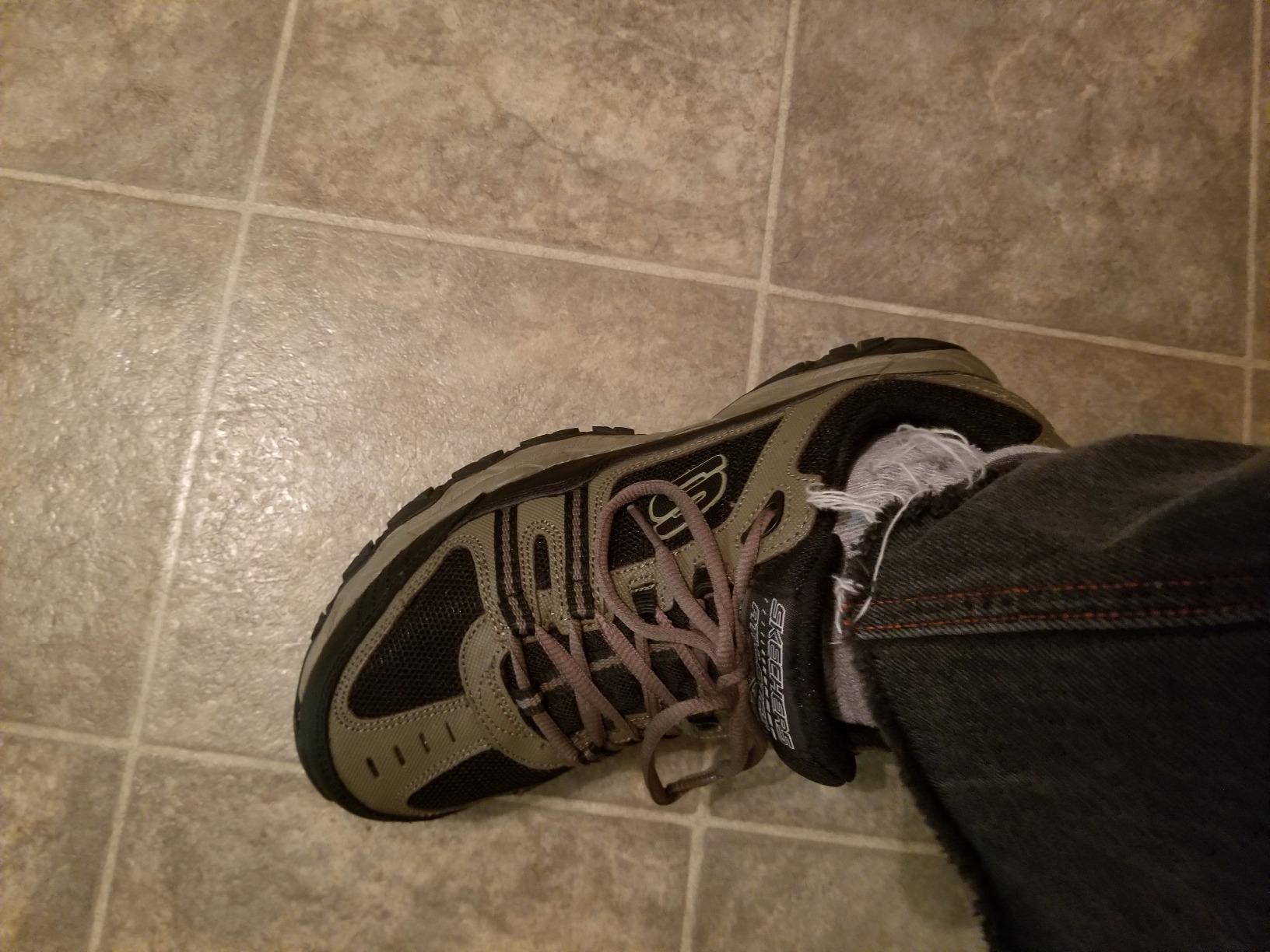
The Good and The Bad
Bottom Line: The Skechers After Burn Memory Fit delivers outstanding initial comfort at a budget-friendly price, but durability concerns make it a short-term solution rather than a long-term investment.
| Aspect | Rating |
|---|---|
| Immediate Comfort | Excellent |
| Long-term Value | Below Average |
| Build Quality | Fair |
| Price Point | Competitive |
Who Should Buy the Skechers After Burn?
Best for:
- Guys seeking immediate comfort for daily wear
- Those who replace shoes frequently anyway
- Office workers needing casual-appropriate footwear
- Budget-conscious buyers prioritizing short-term comfort
- Men with wider feet who appreciate the sizing options
Skip if you:
- Want shoes that last 12+ months
- Need athletic performance capabilities
- Prefer repairable/sustainable footwear
- Require consistent long-term comfort
- Do significant walking on varied terrain
Better Options for Specific Needs
For Long-term Durability: New Balance 623v3 or Asics Gel-Venture series offer better construction at $70-90.
For Athletic Use: Adidas Cloudfoam or Nike Revolution provide better performance at similar prices.
For Premium Comfort: Brooks Addiction Walker or ASICS Gel-Nimbus offer superior long-term comfort at $120-150.
Final Recommendation
The Skechers After Burn serves a specific niche: guys who want maximum immediate comfort at a budget price and don’t mind the trade-off in longevity. If you typically replace shoes every 6-8 months anyway, these deliver solid value. However, if you’re looking for a long-term daily driver, invest in something more durable.
My recommendation? Buy them if the immediate comfort appeals to you, but go in with realistic expectations about lifespan. At $50, they’re not a terrible investment for short-term use, but don’t expect them to be your go-to shoes for years.
Get the best price on Amazon:
Frequently Asked Questions
How long does the memory foam actually last?
Based on my testing and user feedback, the memory foam starts noticeably compressing around week 4-6 of daily use. By month 3-4, it’s significantly flattened and loses most of its cushioning properties. This timeline varies based on your weight and usage intensity.
Can you replace the memory foam insoles?
No, unfortunately. The memory foam is permanently glued to the shoe and cannot be removed without damaging the shoe. This is a major design limitation that essentially makes the entire shoe disposable once the foam fails.
Do these run true to size?
Yes, they run true to size for most users. I tested the size 10 and found it accurate to my normal sizing. The multiple width options (Medium, Wide, Extra Wide) are a real advantage for guys with different foot shapes.
Are they good for working out?
For light gym activities like walking or basic weightlifting, they’re adequate. However, the memory foam provides too much cushioning for stable lifting, and the weight becomes noticeable during any lateral movements. I’d recommend dedicated athletic shoes for serious workouts.
How do they handle getting wet?
The leather-synthetic upper offers some water resistance, but they’re not waterproof. The bigger issue is that once the interior gets wet, the memory foam takes a long time to dry and can develop odor issues. The outsole also becomes slippery on wet surfaces.
What’s the weight like compared to other casual sneakers?
At 14.3 ounces per shoe (size 10), they’re noticeably heavier than most casual sneakers in this category. This becomes apparent during longer walks and can contribute to foot fatigue over time.
Is the $50 price point worth it?
For short-term use (3-6 months), yes. The immediate comfort and styling make them competitive at this price. However, if you calculate cost-per-wear over longer periods, spending $80-100 on more durable options often provides better value.
How do they compare to other Skechers models?
The After Burn sits in Skechers’ budget casual category. Their Go Walk and Max Cushioning lines offer better long-term comfort and durability at slightly higher price points ($60-80). The After Burn prioritizes immediate comfort over longevity.
Comprehensive Scoring Summary
| Performance Category | Score (1-10) | Weight (importance) | Weighted Score |
|---|---|---|---|
| Initial Comfort | 9.0 | 20% | 1.8 |
| Long-term Comfort | 6.0 | 25% | 1.5 |
| Durability | 4.5 | 25% | 1.125 |
| Value for Money | 6.5 | 15% | 0.975 |
| Versatility | 7.5 | 10% | 0.75 |
| Style/Appearance | 7.0 | 5% | 0.35 |
| Final Weighted Score | 6.8/10 | 6.5 | |
Verdict: Good short-term comfort with concerning long-term durability. Suitable for budget-conscious buyers seeking immediate comfort but not recommended for those wanting lasting value.

